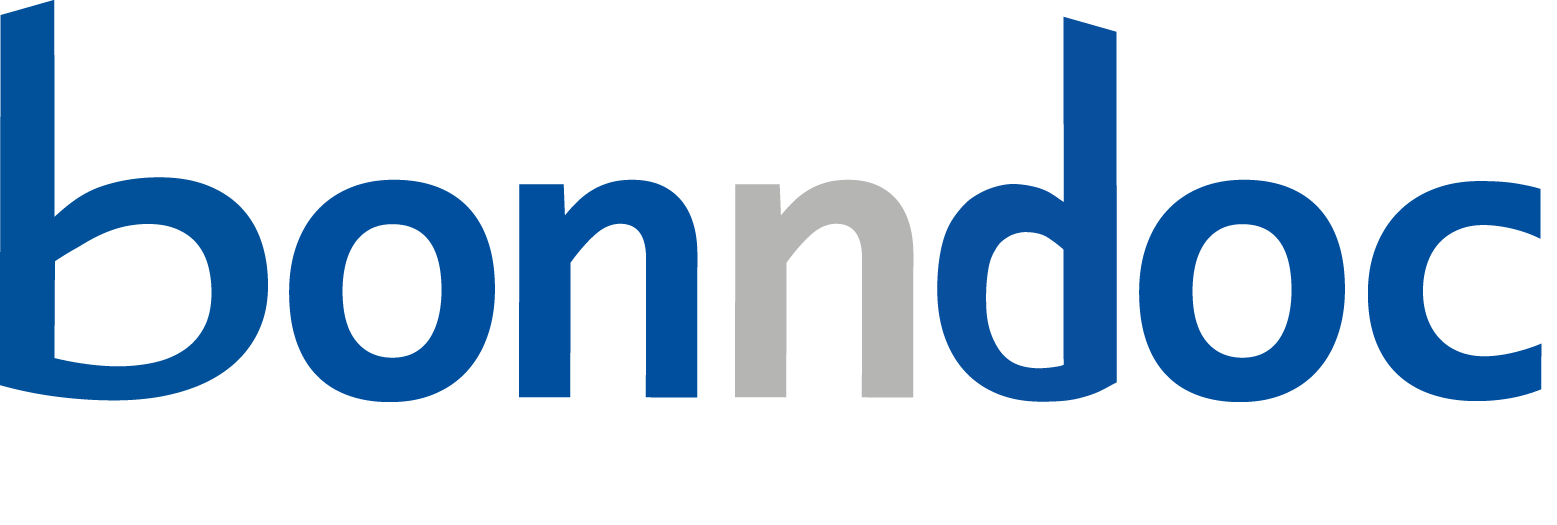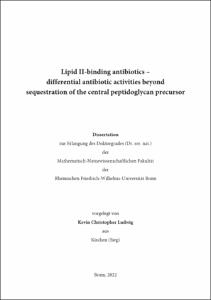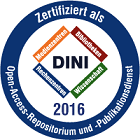Ludwig, Kevin Christopher: Lipid II-binding antibiotics – differential antibiotic activities beyond sequestration of the central peptidoglycan precursor. - Bonn, 2023. - Dissertation, Rheinische Friedrich-Wilhelms-Universität Bonn.
Online-Ausgabe in bonndoc: https://nbn-resolving.org/urn:nbn:de:hbz:5-70627
Online-Ausgabe in bonndoc: https://nbn-resolving.org/urn:nbn:de:hbz:5-70627
@phdthesis{handle:20.500.11811/10806,
urn: https://nbn-resolving.org/urn:nbn:de:hbz:5-70627,
author = {{Kevin Christopher Ludwig}},
title = {Lipid II-binding antibiotics – differential antibiotic activities beyond sequestration of the central peptidoglycan precursor},
school = {Rheinische Friedrich-Wilhelms-Universität Bonn},
year = 2023,
month = apr,
note = {Antibiotic resistance has reached crisis proportions and is a leading mortality factor worldwide. Despite the relevance for public health globally, the antibiotic-discovery pipeline is drying up. The reason for the steep decline of novel antibiotics approved is manifold and complex, including overmining of antibiotic sources, decreased economic attractiveness, as well as regulatory hurdles.
Besides the identification of new antibiotic compounds, it is essential to arrive at a better understanding of their mechanisms of action and the cellular function(s) of the target molecule(s). Most successful antibiotics trigger pleitropic cellular consequences upon primary target inhibition. Understanding the complex antibiotic downstream effects that follow primary target attack is of utmost importance for rational drug development.
Bacterial cell wall biosynthesis is historically known as a most attractive target pathway for antibiotic intervention. Cell wall targeting antibiotics usually inhibit enzymes or block lipid-bound intermediates of the multistep cell wall biosynthesis process. Among the latter, the ultimate peptidoglycan prescuror lipid II represents a most relevant target structure. This thesis particularly focuses on the mechanisms of action elucidation of natural and synthetic cell wall biosynthesis inhibitors from distinct chemical classes.
Chapters 1 to 4 describe the mode of action analysis of natural products. The antibacterial activity of the Streptomyces-derived lasso peptide siamycin-I was shown to be based on interference with membrane-bound steps of peptidoglycan biosynthesis through specific interaction with the pyrophosphate moiety of lipid II (chapter 1). The identification of a tripartite complex of the clinically approved lipopeptide daptomycin with undecaprenyl-coupled cell wall intermediates and the membrane phosholipid phosphatidylglycerol deciphers the long-time enigmatic molecular target and reconciles previous controversial mechanism of action studies. In a refined model, daptomycin captures the essential undecaprenyl-coupled intermediates and hence blocks cell wall biosynthesis which consequently leads to bacterial cell death (chapter 2). The novel cyclodepsipeptides hypeptin and clovibactin, that both share structural features with teixobactin, block cell wall biosynthesis by specificially binding to multiple cell wall precursors that have an undecaprenyl pyrophosphate-moiety in common. Both peptides efficiently kill bacterial pathogens without detectable resistance (chapters 3 and 4).
Lipid II-binding antibiotics are generally large and complex natural products. Chapters 5 and 6 describe the mode of action analysis of synthetic small molecule inhibitors. The 1-amino substituted tetrahydrocarbazole (THCz) class represents the first synthetic small molecule (<500 Da) lipid II binder described. THCz block cell wall biosynthesis by binding to undecaprenyl pyrophospate-containing lipid intermediates of peptidoglycan, teichoic acid and capsule biosynthesis pathways. Importantly, the central diamino motif of THCz was required for target interaction (chapter 5). The chlorine-substituted carbazole compound DCAP was previously anticipated to exclusively disrupt the bacterial membrane. However, the mechanism of action of DCAP was found to be more targeted and multifaceted than previously anticipated. DCAP binds to lipid II and undecaprenyl pyrophosphate-coupled lipid intermediates of wall teichoic acid and capsule biosynthesis, thereby blocking cell wall biosynthesis and cell division leading to strong lytic effects (chapter 6).},
url = {https://hdl.handle.net/20.500.11811/10806}
}
urn: https://nbn-resolving.org/urn:nbn:de:hbz:5-70627,
author = {{Kevin Christopher Ludwig}},
title = {Lipid II-binding antibiotics – differential antibiotic activities beyond sequestration of the central peptidoglycan precursor},
school = {Rheinische Friedrich-Wilhelms-Universität Bonn},
year = 2023,
month = apr,
note = {Antibiotic resistance has reached crisis proportions and is a leading mortality factor worldwide. Despite the relevance for public health globally, the antibiotic-discovery pipeline is drying up. The reason for the steep decline of novel antibiotics approved is manifold and complex, including overmining of antibiotic sources, decreased economic attractiveness, as well as regulatory hurdles.
Besides the identification of new antibiotic compounds, it is essential to arrive at a better understanding of their mechanisms of action and the cellular function(s) of the target molecule(s). Most successful antibiotics trigger pleitropic cellular consequences upon primary target inhibition. Understanding the complex antibiotic downstream effects that follow primary target attack is of utmost importance for rational drug development.
Bacterial cell wall biosynthesis is historically known as a most attractive target pathway for antibiotic intervention. Cell wall targeting antibiotics usually inhibit enzymes or block lipid-bound intermediates of the multistep cell wall biosynthesis process. Among the latter, the ultimate peptidoglycan prescuror lipid II represents a most relevant target structure. This thesis particularly focuses on the mechanisms of action elucidation of natural and synthetic cell wall biosynthesis inhibitors from distinct chemical classes.
Chapters 1 to 4 describe the mode of action analysis of natural products. The antibacterial activity of the Streptomyces-derived lasso peptide siamycin-I was shown to be based on interference with membrane-bound steps of peptidoglycan biosynthesis through specific interaction with the pyrophosphate moiety of lipid II (chapter 1). The identification of a tripartite complex of the clinically approved lipopeptide daptomycin with undecaprenyl-coupled cell wall intermediates and the membrane phosholipid phosphatidylglycerol deciphers the long-time enigmatic molecular target and reconciles previous controversial mechanism of action studies. In a refined model, daptomycin captures the essential undecaprenyl-coupled intermediates and hence blocks cell wall biosynthesis which consequently leads to bacterial cell death (chapter 2). The novel cyclodepsipeptides hypeptin and clovibactin, that both share structural features with teixobactin, block cell wall biosynthesis by specificially binding to multiple cell wall precursors that have an undecaprenyl pyrophosphate-moiety in common. Both peptides efficiently kill bacterial pathogens without detectable resistance (chapters 3 and 4).
Lipid II-binding antibiotics are generally large and complex natural products. Chapters 5 and 6 describe the mode of action analysis of synthetic small molecule inhibitors. The 1-amino substituted tetrahydrocarbazole (THCz) class represents the first synthetic small molecule (<500 Da) lipid II binder described. THCz block cell wall biosynthesis by binding to undecaprenyl pyrophospate-containing lipid intermediates of peptidoglycan, teichoic acid and capsule biosynthesis pathways. Importantly, the central diamino motif of THCz was required for target interaction (chapter 5). The chlorine-substituted carbazole compound DCAP was previously anticipated to exclusively disrupt the bacterial membrane. However, the mechanism of action of DCAP was found to be more targeted and multifaceted than previously anticipated. DCAP binds to lipid II and undecaprenyl pyrophosphate-coupled lipid intermediates of wall teichoic acid and capsule biosynthesis, thereby blocking cell wall biosynthesis and cell division leading to strong lytic effects (chapter 6).},
url = {https://hdl.handle.net/20.500.11811/10806}
}






